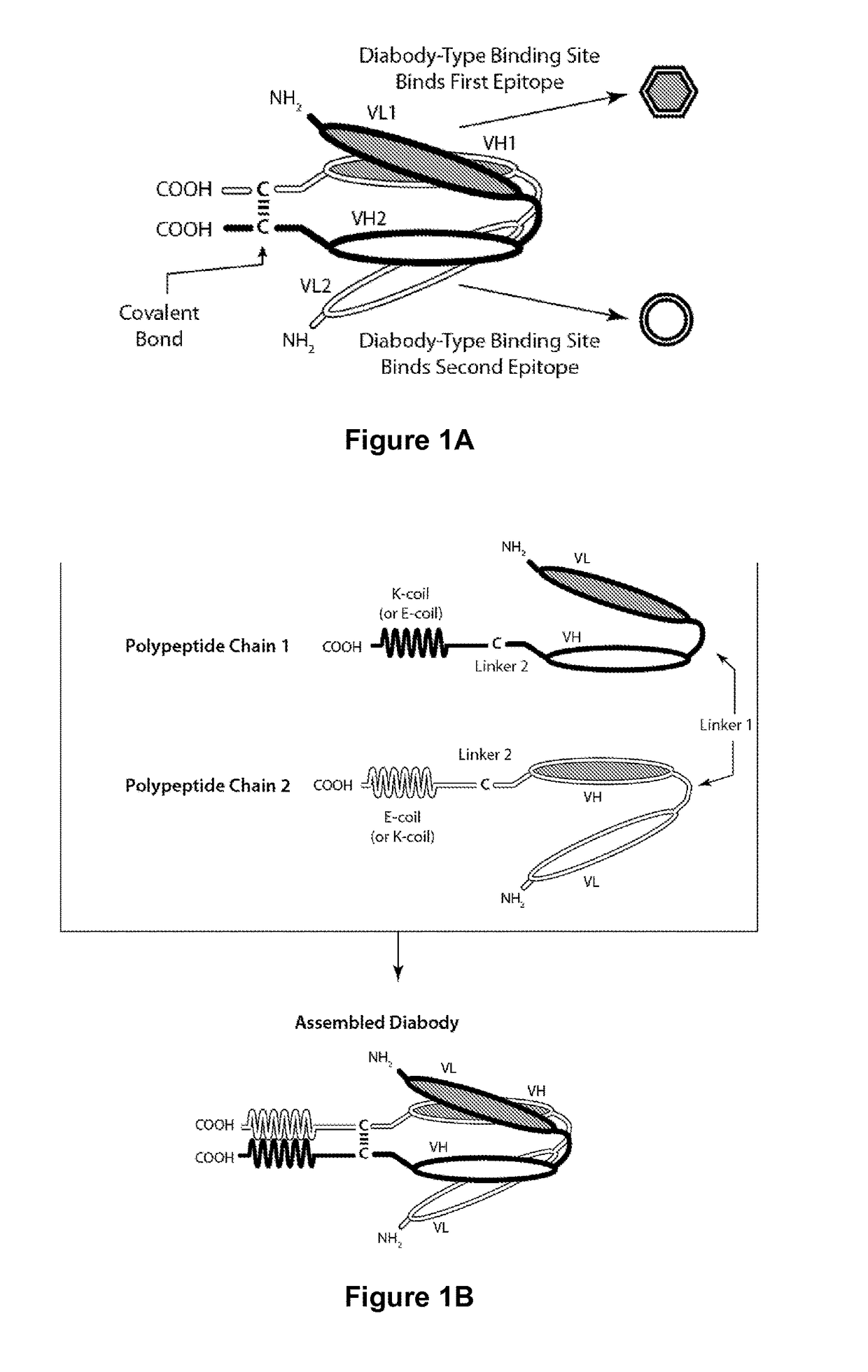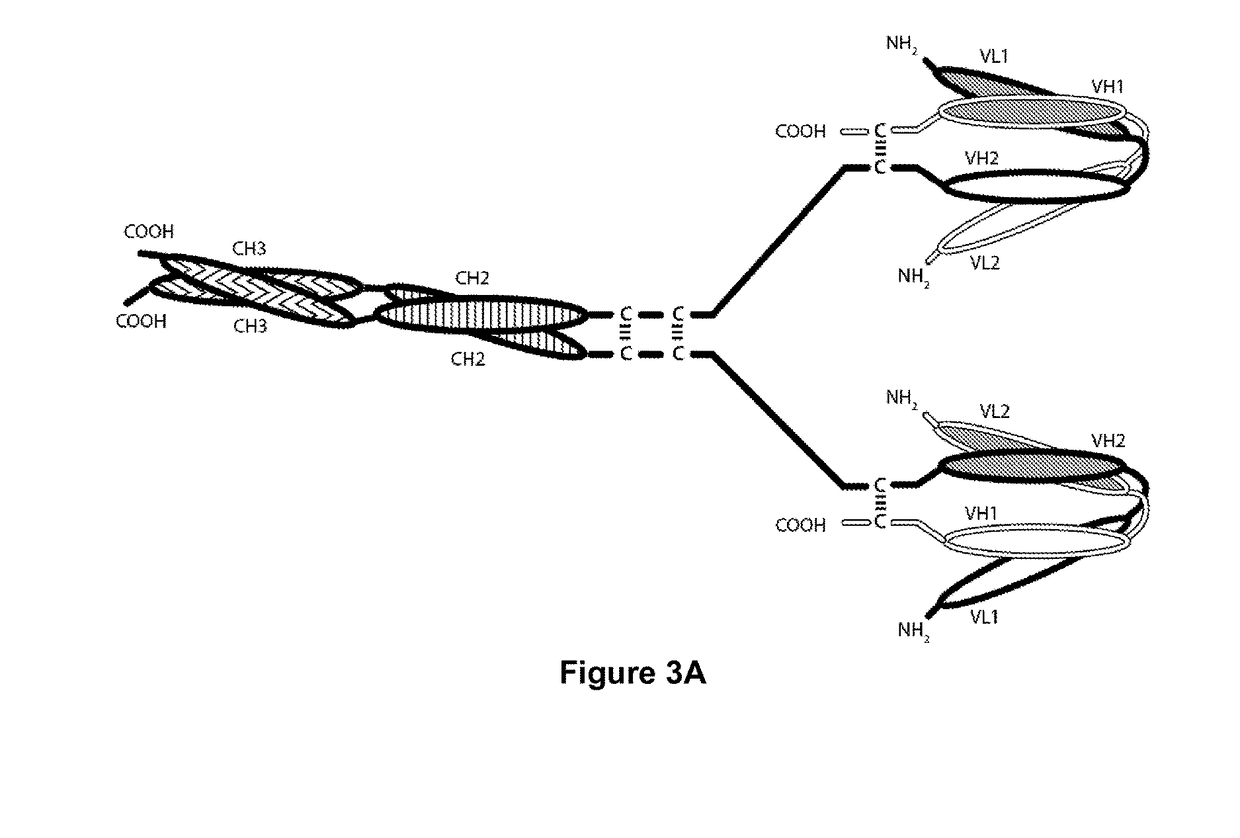Tri-Specific Binding Molecules and Methods of Use Thereof
a technology of binding molecules and specific molecules, applied in the field of tri-specific binding molecules, can solve the problems of no mechanism for their production, no disclosure of their structure, and no compromise and trade-offs
- Summary
- Abstract
- Description
- Claims
- Application Information
AI Technical Summary
Benefits of technology
Problems solved by technology
Method used
Image
Examples
example 1
Production and Properties of Exemplary Anti-CD3, Anti-CD8, Anti-B7-H3 Tri-Specific Binding Molecules
[0397]In order to develop a therapeutic molecule that would exhibit greater specificity to CD8+ T cells, and more potent re-directed killing, Tri-Specific Binding Molecules were constructed having the ability to coordinately bind to CD3, to CD8 and to a Disease-Associated Antigen. The produced Tri-Specific Binding Molecule additionally possessed an Fc Domain to enhance the half-life of the Tri-Specific Binding Molecule in vivo. The general structures of the Tri-Specific Binding Molecules are shown in FIGS. 4A-4D. An exemplary Tri-Specific Binding Molecule specific for the Disease-Associated Antigen B7-H3 was constructed. The Tri-Specific Binding Molecule is termed B7-H3 mAb 1 / CD3 mAb 2 / CD8 mAb 1 to denote the relative positions of the Binding Domains within the Tri-Specific Binding Molecule. The B7-H3 Binding Domain occupies the Site A position, the CD3 Binding Domain occupies the Sit...
example 2
Effect of CD8 Binding Domain on Re-Directed Cytotoxicity
[0411]In order to assess the effect of CD8 specificity, a second Tri-Specific Binding Molecule specific for the Disease-Associated Antigen B7-H3 was constructed utilizing a different CD8 antibody Variable Domain sequence. The B7-H3 Variable Domain specificities and CD3 Variable Domain specificities were identical to those used to construct the B7-H3 mAb 1 / CD3 mAb 2 / CD8 mAb 1 Tri-Specific Binding Molecule. The Tri-Specific Binding Molecule is termed B7-H3 mAb 1 / CD3 mAb 2 / CD8 mAb 2 and was composed of four different polypeptide chains (Table 8).
TABLE 8PolypeptideChainDomainsBinding Affinity1VL(B7-H3 mAb 1)-VH(CD3Light Chain: B7-H3mAb 2)-E-Coil-(CH2—CH3)Heavy Chain: CD32VL(CD3 mAb 2)-Light Chain: CD3VH(B7-H3 mAb 1)-K-CoilHeavy Chain: B7-H33Heavy Chain CD8 mAb 2CD84Light Chain CD8 mAb 2CD8
[0412]The amino acid sequence of the first polypeptide chain of the B7-H3 mAb 1 / CD3 mAb 2 / CD8 mAb 2 Tri-Specific Binding Molecule is (SEQ ID NO:6...
example 3
Effect Of Domain Positions On Re-Directed Cytotoxicity
[0419]In order to assess the effect of position for a given Binding Domain (CD3, CD8 and Disease-Associate Antigen) within the Tri-Specific Binding Molecule (Site A, Site B and Site C), several additional Tri-Specific Binding Molecules were constructed. Table 9 shows the Tri-Specific Binding Molecules and the location (Site A, Site B and Site C) of the various Binding Domains (CD3, CD8 and Disease-Associated Antigen).
TABLE 9Tri-Specific Binding MoleculeSite ASite BSite CB7-H3 mAb 1 / CD3 mAb 2 / CD8 mAb 1B7-H3CD3CD8Tri-Specific Binding MoleculemAb 1mAb 2mAb 1CD3 mAb 2 / CD8 mAb 1 / B7-H3 mAb 1CD3CD8B7-H3Tri-Specific Binding MoleculemAb 2mAb 1mAb 1B7-H3 mAb 1 / CD8 mAb 1 / CD3 mAb 2B7-H3CD8CD3Tri-Specific Binding MoleculemAb 1mAb 1mAb 2
[0420]The construction and sequence of the B7-H3 mAb 1 / CD3 mAb 2 / CD8 mAb 1 Tri-Specific Binding Molecule was described above. For the additional two Tri-Specific Binding Molecules (CD3 mAb 2 / CD8 mAb 1 / B7-H3 mAb...
PUM
| Property | Measurement | Unit |
|---|---|---|
| Composition | aaaaa | aaaaa |
Abstract
Description
Claims
Application Information
 Login to View More
Login to View More - R&D
- Intellectual Property
- Life Sciences
- Materials
- Tech Scout
- Unparalleled Data Quality
- Higher Quality Content
- 60% Fewer Hallucinations
Browse by: Latest US Patents, China's latest patents, Technical Efficacy Thesaurus, Application Domain, Technology Topic, Popular Technical Reports.
© 2025 PatSnap. All rights reserved.Legal|Privacy policy|Modern Slavery Act Transparency Statement|Sitemap|About US| Contact US: help@patsnap.com



